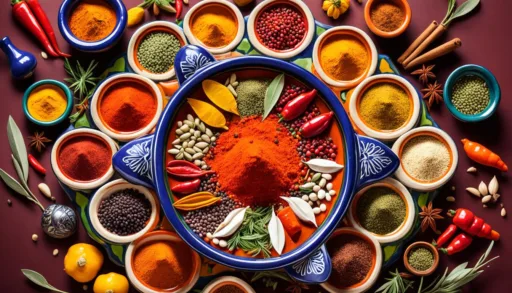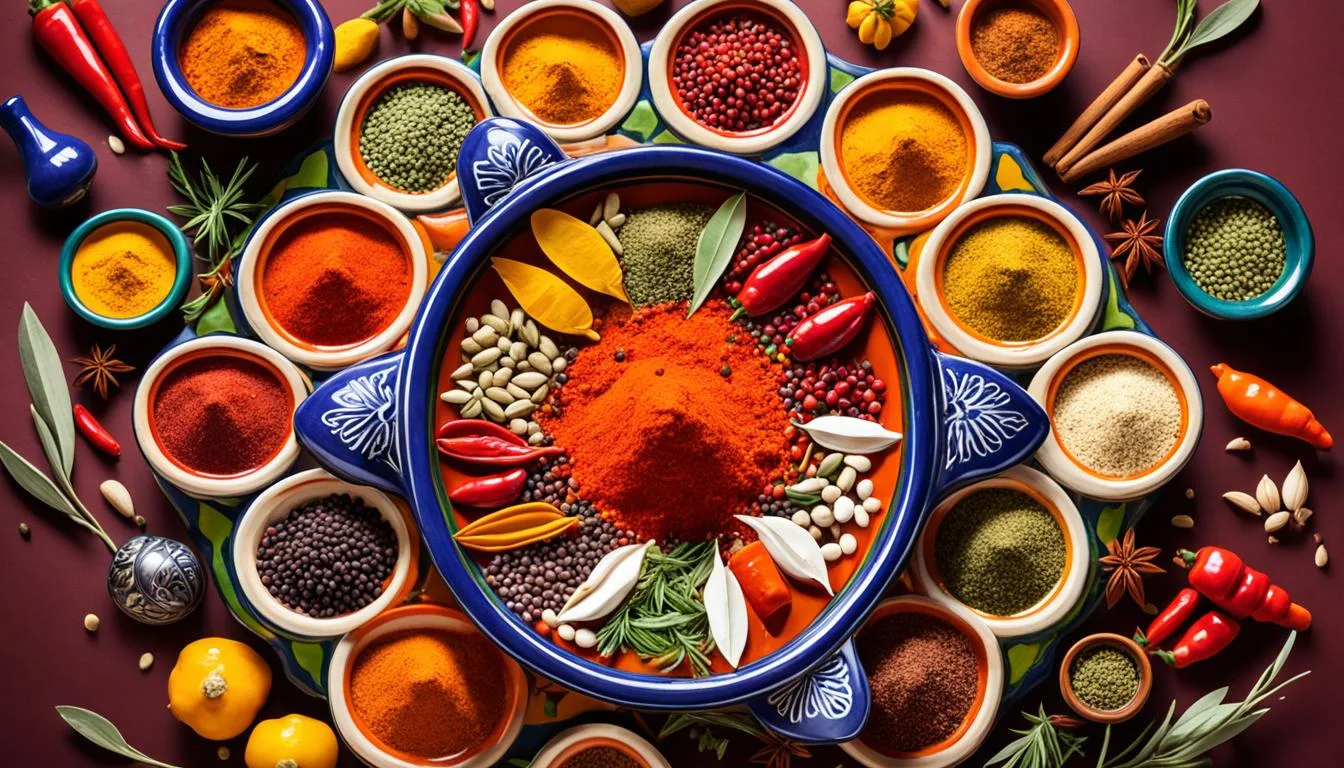Embark on a sensory expedition through the winding souks and sun-soaked landscapes of Morocco, where a feast for the senses awaits you. Moroccan Cuisine Discoveries unfold a story in every dish, where traditional Moroccan food serves as a canvas for the vibrant hues and flavors that define a nation’s culinary identity. We invite you to savor the richness of authentic Moroccan dishes, each a testament to a culinary heritage seasoned by time and the whispers of ancestral kitchens. A land where the art of cooking is akin to alchemy, Morocco invites you, through its cumin-scented alleys and saffron-touched mountains, to lose yourself in a world where every bite is a journey.
Prepare to be enchanted by more than just the tales of One Thousand and One Nights; let the real magic unfold in the heart of Moroccan kitchens. Delight in the symphony of spices and the warmth of Moroccan hospitality as you break bread beneath the canvas of a North African sky. Discover why the country’s storied past and vibrant present have transformed it into a mecca for epicureans and cultural enthusiasts alike.
Key Takeaways
- Uncover the mysteries of spices that are central to Moroccan cuisine discoveries.
- Explore the rich tapestry of traditional Moroccan food and its intertwined cultural influences.
- Get a taste of the stories each authentic Moroccan dish carries with it through centuries.
- Discover the culinary threads that bind Moroccan cuisine to its Andalusian, Berber, and Mediterranean roots.
- Embark on a virtual journey to the heart of Morocco’s famed gastronomy and its social significance.
Epicurean Introduction to Moroccan Cuisine Discoveries
Embark on an epicurean journey through the heart of North Africa as we delve into the vibrant tapestry of Moroccan cuisine. Known for its robust flavors and aromatic spices, Moroccan cooking is an artful blend of history and tradition enriched by centuries of cultural exchange.
The Influence of Neighboring Cultures on Moroccan Cuisine
The crossroads of Africa and Europe, Morocco’s strategic location has rendered it a culinary confluence zone, where Berber staples interlace with Arabic, Andalusian, and Mediterranean influences. This sublime intermingling has birthed a unique collection of Moroccan recipes — each an olfactory and gustatory celebration of its diverse heritage.
Essential Moroccan Spices and Flavors: A Symphony of Tastes
At the core of Moroccan cooking lies a bountiful larder of spices and flavors. Quintessentially Moroccan spices such as cumin, coriander, cinnamon, and the treasured saffron are integral to creating the profound and multifaceted flavor profiles that Moroccan recipes are celebrated for.
- Ras el Hanout – the hallmark spice blend encapsulating over a dozen components
- Harissa – a fiery red paste that adds zest to dishes
- Preserved lemons – adding a bright, complex citrus note
Tools and Techniques: The Foundations of Authentic Moroccan Cooking
The enchantment of Moroccan cooking techniques is often found within its traditional kitchens. Essential tools such as the tagine – a conical clay pot – slow-cooks ingredients to tender perfection, infusing them with rich, concentrated flavors. This indigenous method of cooking is emblematic of Moroccan culinary ingenuity and is vital for the accurate recreation of authentic Moroccan recipes.
| Cooking Tool | Purpose | Dish Example |
|---|---|---|
| Tagine | Slow-cooking meats and vegetables | Lamb Tagine with Apricots |
| Couscoussier | Steaming couscous and vegetables | Seven Vegetable Couscous |
| Chermoula | Marinade for fish and seafood | Chermoula Grilled Mackerel |
With a coveted culinary heritage steeped in the practice of sharing meals, Moroccan cooking extends beyond flavors and ingredients; it fosters connection and community. Thus, to fully experience Moroccan spices and flavors, one must also embrace the convivial spirit that accompanies Moroccan cooking techniques and recipes.
The Cultural Tapestry of Moroccan Food
The magnetism of Moroccan cuisine lies in its remarkable diversity, reflecting a centuries-old interweaving of cultural influences that have seasoned its history. The imprint of Berber, Arab, and Mediterranean traditions is evident in the variety of flavors that grace the Moroccan table. It’s in this context that traditional Moroccan food finds its identity, becoming more than mere sustenance—it becomes a story, a testament to the country’s rich and nuanced cultural heritage.
Berber, Arab, and Mediterranean Culinary Traditions
The foundations of traditional Moroccan food are deeply rooted in the daily rhythms of Berber village life, the sophistication of Arab kitchens, and the fresh, aromatic inclinations of Mediterranean cuisine. Each cultural thread adds depth to the fabric of Moroccan culinary practices, shaping a heritage renowned for its vibrant ingredients, bold flavors, and intricate preparation methods that have been refined over generations.
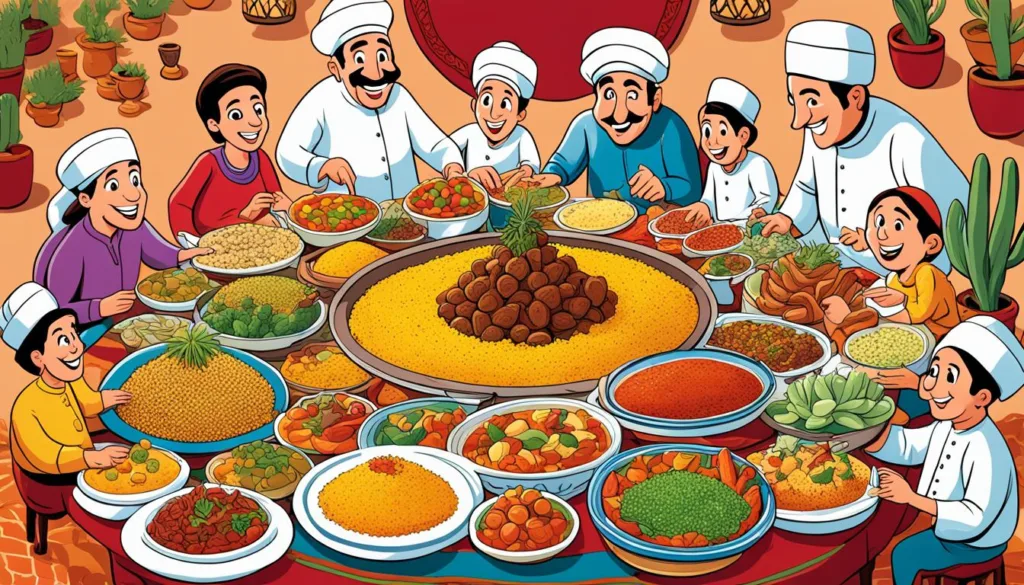
Tagine and Couscous: The Hallmarks of Moroccan Family Meals
Emblematic of Moroccan family meals, the tagine and couscous stand as monuments to the communal spirit of Moroccan dining. Served in intricately designed earthenware, tagines encapsulate the skill of slow-cooking to perfection, while couscous, steamed and fluffed to cloud-like softness, traditionally concludes the weekly Friday family gathering, reinforcing the shared experience of mealtime.
| Cultural Significance | Tagine | Couscous |
|---|---|---|
| Origins | Berber Innovation | Maghreb Staple |
| Ingredients | Meats, Vegetables, Spices | Semolina, Vegetables, Sauces |
| Cooking Method | Slow Cooked in Earthenware | Steamed |
| Occasions | Everyday and Celebrations | Traditional Friday Meal |
| Symbolism | Unity and patience | Prosperity and blessing |
The Social Significance of Food in Moroccan Culture
Moroccan family meals epitomize the social importance of food in the country’s culture. Integral to gatherings, ceremonies, and the daily act of breaking bread, food is the mortar that binds community and family, transcending taste to offer nourishment for relationships and traditions alike. The generosity of a Moroccan table, heaped with dishes meant to be shared, communicates the very spirit of togetherness and the integral value placed on hospitality.
- Gastronomical Generosity: Serving as a gesture of hospitality and affection.
- Communal Harmony: Eating from the same plate to signify unity and fellowship.
- Celebratory Fervor: Festive dishes that mark special occasions and milestones.
A Pantry Full of Moroccan Delights
When one thinks of traditional Moroccan food, the mind immediately conjures up images of dishes rich with complex Moroccan spices and flavors. The bio-diversity of Morocco’s landscape is reflected well in the extensive list of ingredients stocked in a local kitchen pantry, which contribute to the unforgettable experiences diners have at the best Moroccan restaurants. One needs only to peer inside a Moroccan pantry to understand the heart of its culinary excellence.
Essential couscous, various legumes, dried fruits, and an impressive spectrum of spices could be found on the shelves. These great many ingredients are not only the backbone of Moroccan cuisine but also a window into the culture and geography of the place. From fertile valleys to the arid desert, each region contributes to the symphony of flavors that are quintessential to Moroccan culinary arts.
| Ingredient | Description | Typical Use |
|---|---|---|
| Couscous | Fine wheat pasta traditionally served with a stew spooned over it | Base for many dishes |
| Ras el Hanout | A spice mix containing sometimes up to thirty different spices | Seasoning for tagines and marinades |
| Preserved Lemons | Lemons pickled in a brine of water, lemon juice, and salt | Added to stews and sauces for a citrusy punch |
| Argan Oil | A nutty oil pressed from the fruit of the Argan tree, native to Morocco | Used as a dipping oil, for dressings, or to drizzle over dishes before serving |
| Mint | Fresh herb that is a staple in Moroccan tea and salads | Consumed daily as part of tea tradition |
| Saffron | The most expensive spice in the world, offering a unique aroma and flavor | Used sparingly to flavor and color dishes |
Exploration of this array of Moroccan spices and flavors is not limited to just the savvy home cook or the curious traveler; those looking to savor the best of what Morocco has to offer might delight in the culinary adventure offered by renowned restaurants. There’s a deep appreciation for these ingredients that can be found not only in the rustic kitchens of Moroccan homes but also within the refined settings of the best Moroccan restaurants from Marrakech to New York.
Exploring Moroccan Street Food and Markets
Amidst the narrow, winding alleys of bustling Moroccan markets, the air is fragrant with the alluring scent of spices and sizzling delicacies. This is the domain where Moroccan street food thrives, offering an authentic immersion into the culinary delights of Morocco. Each vendor’s stall showcases the cultural mosaic of flavors that make Moroccan cuisine renowned worldwide.
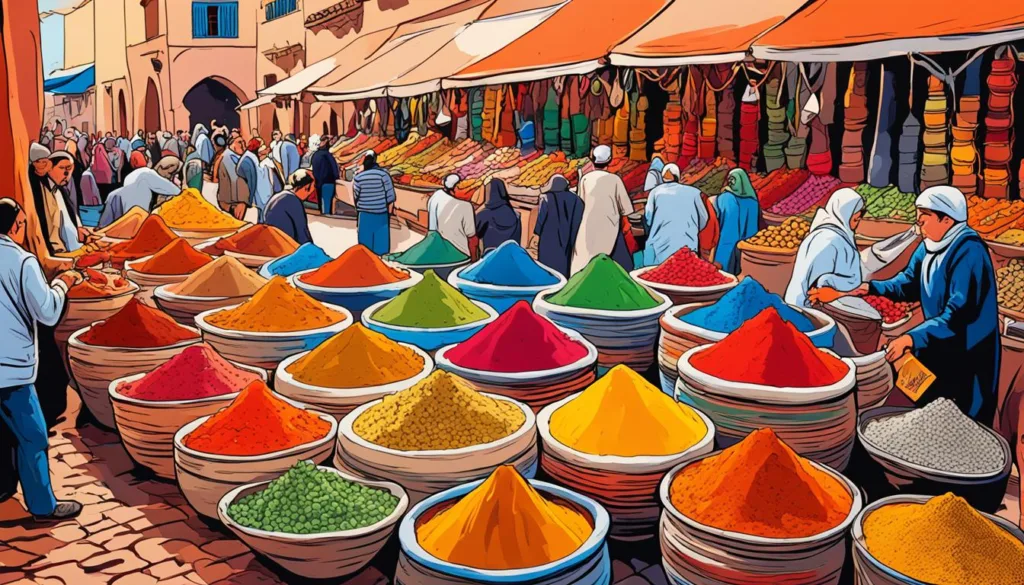
Whether you’re navigating through the colorful array of items in the souks or grabbing a quick bite from a streetside cart, the variety will astonish any food enthusiast. From sizzling meats to sweet, syrupy pastries, each bite is a testament to the intricate heritage of the Moroccan palate.
- Tangia Marrakchia: A slow-cooked marvel, often prepared by men, and best savored with fresh bread.
- Bissara: A hearty fava bean soup that is not only affordable but deeply satisfying on cooler Moroccan evenings.
- Msemen: These flaky, buttery pancakes, often stuffed with fillings, make for a delectable street snack.
| Street Food | Description | Typically Found In |
|---|---|---|
| Harira | Rich and fragrant soup with tomatoes, lentils, chickpeas, and an array of spices. | Ramadan evenings, street corners |
| Brochettes | Juicy skewers of marinated meat, cooked over a blazing fire. | Open-air markets, roadside grills |
| Makouda | Deep-fried potato balls dipped in spicy sauce, a quick and savory treat. | Mobile street vendors |
In the heart of Morocco’s culinary scene, Moroccan markets are not just about food; they are communal hubs where each stall and cart adds to the collective narrative of Moroccan customs and traditions. Experiencing this integral part of Moroccan culture gives visitors an authentic taste of everyday life in this vibrant and flavor-filled country.
Traditional Moroccan Food: A World of Flavorful Stews and Grains
Embark on a sensory exploration into the heart of North Africa with a dive into the enchanting world of Moroccan cuisine discoveries. Celebrated for its vibrant flavors and diverse offerings, Moroccan recipes embrace a rich tapestry of ingredients and techniques that have been perfected over centuries. Among these culinary treasures, stews and grains stand tall as pivotal elements of traditional Moroccan food.
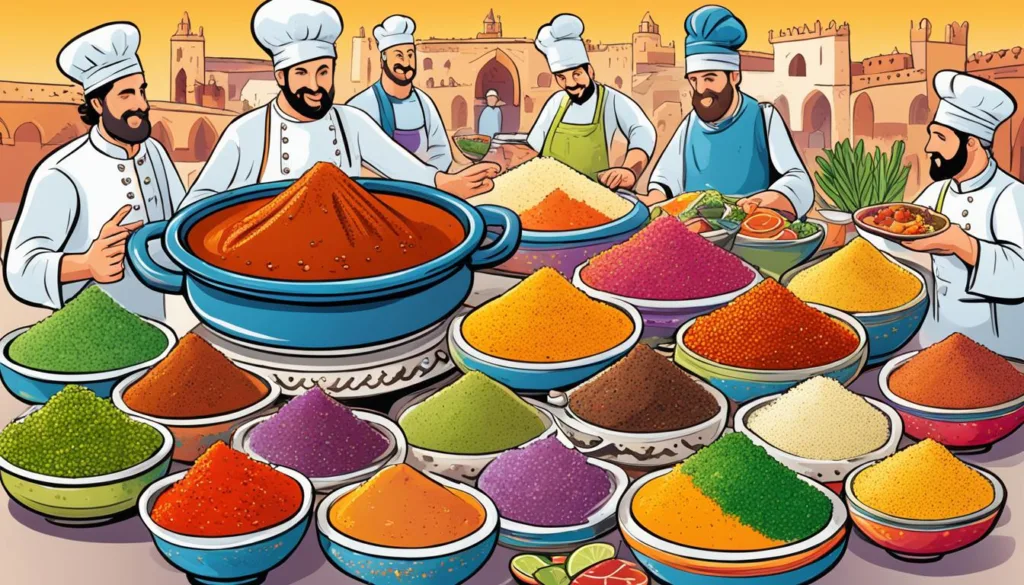
In the pantheon of Moroccan cuisine, certain dishes are elevated to iconic status due to their profound flavor profiles and communal prominence. These dishes not only tantalize the palate but also capture the essence of Moroccan culture and hospitality.
Iconic Moroccan Recipes: Tagine, Couscous, and Beyond
The mystique of Morocco comes to life in its signature dish, the tagine. This slow-cooked stew, named after the distinctive earthenware pot it’s cooked in, harmonizes meat, fruits, vegetables, and spices into a succulent melody of flavors. Meanwhile, couscous, the granular staple that accompanies many meals, serves as a versatile base for an array of sumptuous toppings and mix-ins, from roasted vegetables to tender meats.
Hearty Soups and Rustic Breads: Staples of Moroccan Cuisine
Harira, the robust lentil and tomato soup often breaking the fast during Ramadan, offers nourishment and comfort in every spoonful. Accompanying these hearty soups is the ubiquitous Khobz, a rustic bread that’s not only beloved as a side but also revered as a utensil for scooping rich sauces and stews.
Vegetable Tagines: A Vegetarian’s Delight in Morocco
Amidst the aromatic meats and succulent seafood that dominate Moroccan menus, vegetable tagines provide a plant-based haven for vegetarians. These one-pot wonders combine seasonal vegetables, legumes, and a medley of spices to create deeply flavorful and satisfying meals that celebrate Morocco’s bountiful produce.
Morocco’s culinary lineage is steeped in a spirit of inclusivity that ensures there’s a delectable bite for every type of diner, from meat enthusiasts to vegetarians alike. Our journey into Moroccan cuisine discoveries continues to reveal the gastronomic genius behind traditional Moroccan food—one sumptuous stew and grain at a time.
High Moroccan Cuisine: Best Moroccan Restaurants to Visit
Moroccan restaurants are the gateways to a world where luxury dining meets cultural tradition. Gastronomes eager for Moroccan cuisine discoveries will find that the opulent settings of the finest eateries in Marrakech, Rabat, and Casablanca offer much more than just a meal—they present a culinary narrative steeped in the rich history of Moroccan flavors, intensified by modern gastronomic flair.
Experience Luxury Dining: The Culinary Gems of Marrakech, Rabat, and Casablanca
The culinary landscape of Moroccan cities is studded with gems that offer an immersive luxury dining experience. Here, one can expect to be greeted by plush interiors that reflect both the grandeur of Moroccan architecture and the hospitality intrinsically linked to its food culture.
Navigating Morocco’s Dining Scene: Tips for Gourmands
As you set out to explore the vibrant dining scene, keep in mind that the best Moroccan restaurants often fuse tradition with inventive culinary techniques. Look for places that honor the timeless recipes but are not afraid to add a contemporary twist—think classic tagines with an unexpected burst of flavor or couscous paired with avant-garde accompaniments.
Fusion and Innovation in Contemporary Moroccan Restaurants
In Morocco, the traditional and the contemporary dance in harmony. Contemporary Moroccan restaurants are redefining the gastronomic experience by pushing the boundaries of classic cooking. It’s not just about eating; it’s about engaging with a culture that celebrates its past while boldly embracing the future of culinary innovation.
| City | Restaurant | Signature Experience | Innovative Element |
|---|---|---|---|
| Marrakech | Le Jardin des Épices | Roof-top dining overlooking the Atlas Mountains | Spice-infused cocktails |
| Rabat | Villa Mandarine | Garden setting with authentic art pieces | Modern twists on traditional lamb dishes |
| Casablanca | Maison Blanche | Elegant dining room with a view of the Hassan II Mosque | Seafood tagine with saffron foam |
Moroccan Culinary Traditions and Rituals
The heart of Morocco’s rich culture is often found simmering in the kitchens and steaming in the cups of its iconic mint tea. Here, culinary rituals are not mere procedures but acts of love, heritage, and hospitality. The preparation of food and drink intertwines with daily life, stitching together a tapestry rich with aroma and flavor that is unique to this North African nation.
The Art of Moroccan Mint Tea Preparation
The ceremonial preparation of Moroccan mint tea is a practice steeped in history and a staple in every Moroccan household. Revered for its refreshing flavor and soothing properties, mint tea is not simply a drink but a sign of friendship and a gesture of welcome. The art involves boiling water and steeping green tea, followed by the addition of fresh mint leaves and a generous amount of sugar, all presented in ornate teapots and glasses.
Festive Foods: Celebratory Dishes in Moroccan Culture
Celebrations in Morocco are incomplete without the presence of festive foods that bring together families and communities. From the savory layers of Pastilla to the sweet hints of traditional Moroccan cookies, each dish serves a purpose in marking the significance of an event. For instance, the elaborate preparation of a lamb tagine is a symbol of hospitality during Eid al-Adha, while Pastilla is a must-have at weddings and other joyous occasions.
The Role of Bread in Moroccan Meals: More Than Just a Side
Moroccan bread, or Khobz, is far more than just an accompaniment to a meal; it is central to Moroccan dining. Acting as a utensil for scooping food, Khobz is present at almost every meal and is revered for its versatility and importance. The traditional Moroccan bread, with its crusty exterior and soft interior, is a perfect complement to the rich and flavorful stews of Moroccan cuisine.
Decadent Moroccan Desserts and Confections
The realm of Moroccan desserts and confections is where the narrative of flavors unfolds into a sweet symphony. Distinctive both in taste and presentation, the assortment of Moroccan pastries and sweets not only conclude a meal but also embellish the cultural fabric with their delightful existence. From the rich almond-centric treats to the sticky ambrosia of honey cakes, Moroccan desserts are as much a feast for the eyes as they are for the palate.
Exploring the Sweetness of Moroccan Pastries and Sweets
In the pantheon of delectable treats, few are as revered as the storied pastries and sweets of Morocco. Confections, fragrant with the aroma of orange blossom water and glistening with honey glazes, hold a cherished spot in the hearts of Moroccans and visitors alike. Let’s delve into some of the cherished delights that Moroccan patisseries proudly offer.
Almond Treats and Honey Cakes: A Confectionery Tradition
Almonds are the crowning jewels in Moroccan sweets, playing a starring role in the creation of myriad desserts that grace the Moroccan table. These versatile nuts are ground, sliced, and sometimes left whole to be used in recipes that are steeped in tradition and embraced by generations.
| Moroccan Dessert | Main Ingredients | Description |
|---|---|---|
| Kaab el ghzal | Almond meal, orange blossom water, sugar, pastry dough | Also known as ‘gazelle’s horns’, these crescent-shaped pastries encase a fragrant almond filling. |
| Chebakia | Flour, honey, sesame seeds, anise | This flower-shaped treat is fried and then soaked in honey, often served during Ramadan. |
| Baklava | Filo dough, nuts, honey syrup | Layers of thin dough and nuts soaked in sweet honey syrup, showcasing the influence of Ottoman cuisine. |
| Almond Briouat | Almonds, cinnamon, filo pastry, honey | These small, triangular pastries are filled with an aromatic blend of almonds and spices before being baked or fried. |
The Closing Bite: Mint Tea and Dessert Pairings
What truly distinguishes the Moroccan dessert experience is the accompanying sip of mint tea. Often referred to as “Moroccan whiskey” due to its cultural significance and ubiquity, this sweet, mint-infused nectar complements the richness of desserts, creating a harmonious finale to an authentic Moroccan feast.
Authentic Moroccan Spices and Where to Find Them
The quest for authentic Moroccan spices is more than a mere shopping trip; it’s a foray into the heart of Moroccan cuisine discoveries. The traditional flavors of Morocco hinge upon the quality and genuineness of the spices used. Whether you’re wandering the vibrant alleys of a Moroccan souk or searching specialty stores abroad, knowing where to find Moroccan spices is crucial for anyone aiming to recreate the magical tastes of Morocco at home.
Whether you’re a seasoned chef or a curious foodie, the allure of Morocco’s cuisine lies within the complexity of its spices. Names like ras el hanout, smoked paprika, and preserved lemon might sound exotic, and rightfully so—these are staples that give Moroccan dishes such iconic depths of flavor.
- Ras El Hanout – a robust blend that can contain over a dozen different spices
- Smoked Paprika – for a subtle, smoky heat
- Preserved Lemon – a tangy addition to many Moroccan cuisines
- Cumin – earthy and slightly peppery, a must-have in any spice repertoire
- Cinnamon – often used in Moroccan savory dishes for a warm complexity
While exotic spices are readily available in Moroccan markets, international enthusiasts now have more access than ever. Many high-quality spice purveyors offer authentic selections either in-store or online. To assist in your quest, here’s a table highlighting popular spices and potential sources:
| Spice | Description | Find It In Morocco | Find It Abroad |
|---|---|---|---|
| Saffron | The golden thread of spices, both precious and flavorful | Marrakech Souk | Gourmet Food Stores |
| Harissa | A fiery chili paste to kick up any dish | Fez Market | Specialty Online Retailers |
| Argan Oil | A versatile oil with a nutty flavor, perfect for cooking or dressings | Essaouira Shops | Organic Markets |
When selecting spices, look for those with vibrant color and a strong aroma — these are indicators of quality and freshness. Moroccan spices, more than mere seasonings, are an invitation to journey through taste to the very soul of Morocco’s rich culinary landscape.
Finally, don’t overlook the value of purchasing directly from local Moroccan vendors. Not only does this ensure the authenticity of the spices, but it also supports the traditional practices and heritage of Moroccan spice production. So the next time you savor a Moroccan dish, remember the spices are not just ingredients; they are the cultural threads that connect us to the enchanting world of Moroccan cuisine discoveries.
Conclusion
Embarking on a culinary journey into the heart of Moroccan cuisine reveals more than just the ingredients and recipes; it uncovers a rich historical tapestry that invites all to delve deeper and explore Moroccan dishes with zest. Throughout this exploration, we’ve encountered a remarkable array of Moroccan cuisine discoveries, each offering an authentic taste of the country’s diverse cultural influences and culinary expertise. From the bustling markets filled with fresh produce and aromatic spices to the luxurious dining rooms that serve up innovative takes on time-honored classics, the gastronomic landscape of Morocco is both vast and inviting.
A Culinary Reflection: Embracing Moroccan Cuisine Discoveries
As we reflect upon the flavors and traditions that define Moroccan cooking, it’s clear that the nation’s fare is a true celebration of its people’s generosity and joie de vivre. The Moroccan kitchen tells a story of communal spirit, as seen in the shared experience of tagines and the hospitality offered with each glass of mint tea. To embrace the extensive Moroccan cuisine discoveries is to commit to a sense of adventure, one that undoubtedly rewards the palate and nourishes the soul.
Moroccan Cuisine: A Gastronomic Invitation to Explore and Enjoy
Our collection of experiences and insights serves as a warm invitation for food lovers worldwide. Whether you’re a curious traveler, an enthusiastic home chef, or simply someone who appreciates the wonders of a well-spiced meal, Moroccan cuisine is set to astound with its variety and vibrancy. We hope to have inspired you to explore Moroccan dishes, engage your senses, and partake in the delightful practices that make Moroccan food a true feast for both the eyes and the taste buds. Here’s to many more discoveries on your culinary ventures!
FAQ
What makes Moroccan cuisine a unique culinary journey?
Moroccan cuisine reflects a tapestry of cultural influences, including Berber, Arab, Andalusian, and Mediterranean. This creates a diverse range of dishes that are rich in flavors and aromas, distinguished by the use of traditional spices and slow-cooking techniques.
What are some essential Moroccan spices and how do they influence the cuisine?
Essential Moroccan spices include cumin, coriander, cinnamon, and saffron. These spices are combined in unique blends to create the symphony of tastes that define Moroccan cuisine, enhancing dishes with warm, aromatic, and subtly sweet flavors.
How are traditional Moroccan cooking techniques important to the cuisine?
Traditional cooking techniques are at the heart of Moroccan food, with tools like the tagine pot essential for preparing authentic dishes. These techniques often involve slow cooking, which allows the flavors to develop and deepen, resulting in tender, aromatic, and rich dishes.
What role does food play in Moroccan culture?
Food in Moroccan culture is much more than sustenance; it’s a form of hospitality, a central part of celebrations, and a means of gathering family and friends. It signifies generosity, relationship-building, and is an essential element of Moroccan identity.
Can you describe some of the traditional Moroccan dishes one might find at a family meal?
Traditional dishes you might find at a Moroccan family meal include tagines—stews cooked slowly in earthenware pots, couscous—steamed granules typically served with meat or vegetable stew, and other staples like Harira soup, B’stilla (a savory pie), and Khobz (bread).
Where can food enthusiasts explore the culinary delights of Morocco?
Enthusiasts can explore Moroccan culinary delights by visiting Moroccan street food markets, where they’ll find an array of snacks and meals like brochettes (grilled meats), fresh and cooked salads, and souks that offer exotic spices. Additionally, the best Moroccan restaurants provide an avenue to experience high Moroccan cuisine.
Are there options for vegetarians in Moroccan cuisine?
Yes, Moroccan cuisine offers a good selection of vegetarian options, particularly in the form of vegetable tagines and salads. Couscous with vegetables is also popular, and many Moroccan soups and sides are plant-based, making the cuisine inclusive for vegetarians.
When considering the best Moroccan restaurants, what should I look for?
Look for restaurants that offer traditional flavors with a modern twist, showcasing both classic Moroccan dishes and innovative creations. Authenticity, creative presentation, and the use of fresh, local ingredients are also good indicators of a high-quality Moroccan dining experience.
What is the social significance of mint tea in Morocco?
Moroccan mint tea, also known as ‘Maghrebi mint tea’, holds cultural significance as a symbol of hospitality, friendship, and tradition. Serving mint tea to guests is a sign of respect and welcome, making it an integral part of Moroccan social interactions.
What kinds of desserts and sweet treats are typical in Moroccan cuisine?
Moroccan desserts include a variety of pastries, cakes, and confections that commonly feature almonds, honey, and filo pastry. Some examples are kaab el ghzal (almond paste-filled crescent cookies), Chebakia (sesame cookies soaked in honey), and Makroud (date-filled semolina cookies).
Where can I find authentic Moroccan spices for my kitchen?
Authentic Moroccan spices can be found in specialty food stores, online markets, and in the souks of Morocco. Look for spice blends like Ras el Hanout and individual spices such as saffron and cumin to add a touch of Moroccan flavor to your cooking.
What should I look forward to when embarking on a journey of Moroccan cuisine discoveries?
Look forward to an enriching culinary experience that includes savoring flavorful tagines, aromatic spices, and sweet confections. Moroccan cuisine offers a variety of textures, tastes, and aromas that cater to a wide range of palates, promising a memorable gastronomic adventure.
